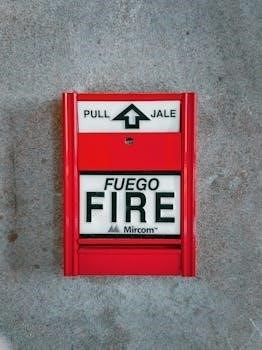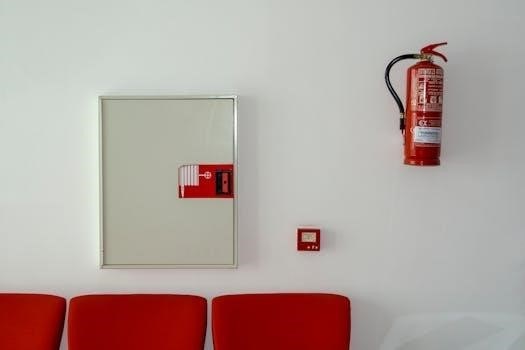First Alert carbon monoxide alarms are essential safety devices designed to provide early warnings of dangerous CO levels. These alarms utilize advanced electrochemical sensors to detect the presence of carbon monoxide, a colorless, odorless, and tasteless gas. Understanding how these devices work is vital for your safety.
Understanding Carbon Monoxide Dangers
Carbon monoxide (CO) is a highly toxic gas that poses a significant threat to human health. It’s often called the “silent killer” because it is invisible, odorless, and tasteless, making it undetectable without specialized equipment like a CO alarm. CO is produced by the incomplete burning of fuels such as natural gas, propane, gasoline, wood, and coal. Common sources include malfunctioning furnaces, water heaters, fireplaces, and vehicle exhaust. Inhaling CO prevents the blood from carrying oxygen, leading to symptoms like headaches, dizziness, nausea, and confusion, which can quickly become severe and potentially fatal. Exposure to high concentrations of CO can cause unconsciousness, brain damage, and death. Understanding the dangers of carbon monoxide and having a working alarm is crucial for maintaining the safety of your home and family. It is critical to install and maintain carbon monoxide detectors properly to ensure early detection and prevent CO poisoning.

Key Features of First Alert CO Alarms
First Alert CO alarms are equipped with advanced technology and user-friendly features. They are designed with electrochemical sensors, audible alarms, digital displays, and silence features. These combined features enhance their effectiveness in detecting and alerting to CO hazards.
Electrochemical CO Sensor Technology
First Alert carbon monoxide alarms utilize advanced electrochemical sensor technology for precise and reliable CO detection. This technology involves a chemical reaction within the sensor that is sensitive to carbon monoxide. When CO molecules come into contact with the sensor, they create a measurable electrical current. The alarm’s internal circuitry interprets this current and triggers an alert when CO levels reach a dangerous threshold. This method allows the sensors to react to low concentrations of CO over time, as well as high concentrations. This electrochemical technology is designed to minimize false alarms from other gases and provide a stable, long-lasting detection mechanism. It is crucial to note that the sensor within the First Alert CO alarms is designed for a specific lifespan and will need to be replaced as specified in the user manual. The sensor’s reliability is what makes First Alert a trusted brand for CO detection. This technology ensures accurate readings, which are vital for the safety of your family.
Audible Alarm and Digital Display
First Alert carbon monoxide alarms are equipped with a loud 85-decibel audible alarm, designed to wake even deep sleepers. This piercing sound is essential for alerting occupants to the presence of dangerous carbon monoxide levels. In addition to the audible alarm, many First Alert models also feature a digital display. This display provides real-time readings of CO levels in parts per million (ppm), allowing you to visually assess the danger. The digital display can also show other information, such as peak CO levels recorded, battery status, or other important alerts. Some models even have a blue backlight for easy viewing in low-light conditions. The combination of the loud audible alarm and the informative digital display ensures that occupants receive both immediate and ongoing warnings of potential carbon monoxide hazards. This dual-warning system is a key feature for enhancing home safety and is why many people trust First Alert.
Silence Feature Functionality
First Alert carbon monoxide alarms often include a silence feature to temporarily mute the audible alarm during nuisance situations, such as when the alarm is triggered by cooking fumes or other non-emergency sources. This feature allows users to quiet the alarm without removing the batteries or disconnecting the device, which is a critical safety aspect. When the silence button is pressed, the alarm will typically be muted for a specific period, usually around four to ten minutes. During this silence period, the alarm will still monitor CO levels, and if dangerous concentrations are still present after the silence period, the alarm will sound again. It’s crucial to understand that the silence feature is not intended to be used as a way to ignore a genuine CO threat, but rather as a temporary measure for non-hazardous situations. The alarm will still indicate a problem with its visual indicators, so it must be resolved.

Installation and Placement Guidelines
Proper installation and placement of First Alert carbon monoxide alarms are critical for their effectiveness; Correct location ensures timely detection of CO. Following guidelines maximizes safety by placing alarms where they can best alert occupants.
Optimal Locations for CO Detectors
For optimal protection, install First Alert carbon monoxide detectors in central locations on each level of your home, particularly near sleeping areas. This ensures that you are alerted even while asleep, as CO exposure is especially dangerous at night. Avoid placing detectors in garages, kitchens, or furnace rooms where normal combustion may trigger false alarms. Do not position them near windows or doors, where drafts can affect their accuracy. Ensure that detectors are not obstructed by furniture or curtains, which can impede airflow. CO is slightly lighter than air, so detectors should be positioned on walls or ceilings, but not too close to corners. It is recommended to place CO alarms within 10 feet of all sleeping areas to provide the best protection. Consider additional detectors near potential sources of CO, such as fuel-burning appliances. Following these guidelines will significantly increase the effectiveness of your First Alert CO detectors.
Height Considerations for Installation
When installing First Alert carbon monoxide detectors, proper height placement is crucial for optimal performance. Because carbon monoxide is slightly lighter than air, it tends to rise, making ceiling or high wall placement ideal. However, it is important to avoid placing the detector too close to the ceiling or in corners as this can create dead air pockets and hinder its ability to detect CO effectively. Ideally, mount the alarm on a wall at least 6 inches from the ceiling or on the ceiling at least 6 inches from any wall. If you place it on a wall, position it so that it is within your normal breathing zone, approximately at eye level for an adult. Avoid placing the detector near the floor, as this may lead to delayed detection. Follow these height guidelines to ensure your First Alert CO detector provides the earliest possible warning.

Operation and Maintenance
Proper operation and maintenance of your First Alert carbon monoxide alarm are crucial for its effectiveness; This section covers battery replacement, regular testing, and understanding alarm signals, ensuring your device works correctly.
Battery Installation and Replacement
First Alert carbon monoxide alarms, especially battery-operated models like the CO410, rely on properly installed and maintained batteries for continuous protection. The initial battery installation is straightforward⁚ simply open the battery compartment, usually located on the back or side of the unit, and insert the batteries according to the polarity markings inside. Ensure the batteries are new and of the correct type specified in your user manual. For alarms with sealed, 10-year batteries, replacement is not needed. However, for models using replaceable batteries, a low-battery indicator will signal the need for new ones. When replacing batteries, always use the manufacturer’s recommended type. After replacement, test the alarm by pressing the test button to verify proper function. Regular battery checks are vital for the alarm’s reliability. Remember to dispose of used batteries responsibly, adhering to local regulations. Some models come with a battery drawer feature, making it easier to slide the batteries in and out. Always refer to your specific model’s user manual for the most accurate battery installation and replacement information.
Testing Procedures for the Alarm
Regularly testing your First Alert carbon monoxide alarm is crucial for ensuring its proper functionality and safeguarding your home. The primary method for testing involves pressing the designated test button, typically found on the alarm’s face. This action simulates a CO event, causing the alarm to sound if it’s working correctly. The test button does not test the actual presence of carbon monoxide, but rather verifies the alarm’s internal circuitry and audibility. When the test button is pressed, the alarm should emit a loud, distinct pattern, usually an 85-decibel sound. The user manual will clarify the specific sound pattern for your model. It is recommended to test your carbon monoxide alarm at least once a month, and always after replacing batteries or after a long absence from home. If the alarm fails to sound during the test, replace batteries if applicable and try again. If the alarm still doesn’t work, replace it immediately. Following the specific testing procedures as outlined in your user manual is paramount for maintaining a reliable safety system.
Understanding Alarm Signals and Indicators
First Alert carbon monoxide alarms utilize distinct signals and indicators to communicate different statuses and warnings. When the alarm detects a dangerous level of carbon monoxide, it will emit a loud, pulsating alarm sound, typically 85 decibels, designed to wake sleeping individuals. In addition to the audible alarm, many models also feature visual indicators like flashing lights or a digital display showing the detected CO level. A low battery signal is also crucial; this is typically indicated by a single beep or flash and must be addressed immediately. Some models have a silence feature, which can temporarily silence the alarm for a few minutes; this does not eliminate the danger. It’s vital to familiarize yourself with the specific signals outlined in your user manual to correctly interpret the alarm’s message. For instance, a continuous alarm signal indicates an immediate threat, requiring evacuation and contacting emergency services. Understanding these signals ensures that you respond effectively to various situations.

Troubleshooting and Support
For any issues with your First Alert carbon monoxide alarm, consult the user manual first, it contains solutions for common problems. Contact customer support for further assistance. Manuals and support information are readily available online.
Common Issues and Solutions
One common issue with First Alert carbon monoxide alarms is the occurrence of false alarms. These can be triggered by various factors, including high humidity levels or the presence of certain cleaning agents. If your alarm is sounding frequently without a clear source of CO, try ventilating the area and ensure no nearby chemicals are interfering. Another frequent problem is low battery warnings. If you notice a blinking light or hear a chirping sound, it’s time to replace the batteries. Make sure you use the correct type of battery as specified in the manual for optimal performance. Sometimes, the alarm may fail to sound during a test or a real CO event. In such cases, double check battery polarity and connections. In addition, if the unit is old or past its expiration date, it should be replaced. Check the devices’ manufacture date. If the alarm is unresponsive even after these steps, consult the user manual for more in-depth troubleshooting steps, or contact customer support for help.
Accessing User Manuals and Support
Accessing user manuals for First Alert carbon monoxide alarms is straightforward. You can often find the manual included in the product packaging. If you’ve misplaced the physical copy, the digital versions are readily available on the First Alert website. Look for the ‘Support’ or ‘Manuals’ section, where you can search by model number to download the correct PDF file. These manuals offer detailed instructions for installation, operation, and troubleshooting, helping you to maximize the effectiveness of your CO alarm. Should you require further assistance or have specific queries not covered in the manual, First Alert provides a customer support line. You can reach them by phone; their contact number is often found on the website or in the manual. For technical issues or warranty-related concerns, this is the recommended avenue for assistance. Additional resources, such as video tutorials or frequently asked question pages, may also be available on the website.